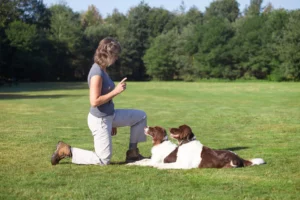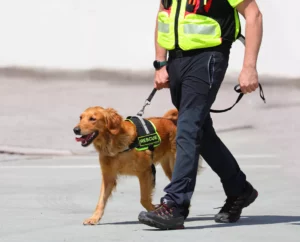By Cathy M. Rosenthal

The moment Roxy hears the front door open, she springs into action. Her ears perk up, her tail starts wagging, and she bolts toward the nearest stuffed animal—usually one missing a nose or with a well-loved squeaker inside. With toy in mouth, she races to the door, tail swishing like a feather duster, ready to greet whoever walks in. But there’s a twist: Roxy doesn’t actually give you the toy. She shows it off like a prized possession, then trots away before you can even think about taking it.
Her pet parent, Patty, who recently adopted Roxy, was puzzled. Was this an invitation to play? Was Roxy just showing she was happy? Or was there something more going on?
As it turns out, this behavior is pretty common—and pretty charming too.
Many dogs, especially retrievers and spaniels like Roxy, are naturally mouthy and enjoy carrying things. Greeting someone at the door with a toy is their way of saying, “I’m excited you’re here!” It may look like an invitation to play, but for many dogs, it’s more of a joyful ritual than a request. Think of it as your dog’s version of a welcome-home parade—with plush toys as the confetti.
This habit likely taps into a dog’s instinct to retrieve or present something to a member of their pack. Some behaviorists even liken it to a low-key version of showing off prey. It also may be a form of appeasement behavior—bringing an object as a social signal to reduce the intensity of the greeting and keep things calm and happy.
In fact, studies in canine social behavior suggest that dogs often use transitional behaviors, like picking up a toy or yawning, to manage excitement or diffuse social tension. For toy-carrying greeters, it’s a way to channel energy into something positive. And for their humans? It’s irresistibly adorable.
You may have also seen dogs grab their leash before a walk or even carry it around the house. This behavior, like toy-carrying, can be linked to excitement, anticipation, or a desire to be involved. For some dogs, holding their leash is their way of saying, “I’m ready, let’s go!” Others use it to self-soothe or as a confidence booster in stimulating environments. Just like with toys, the leash becomes a familiar object they can carry to help regulate their energy or emotions—especially during exciting transitions like going outside or welcoming someone home.
So, if your dog greets guests this way, let them enjoy it. No need to grab the toy or try to turn it into a game unless they clearly invite you to play. In most cases, the toy isn’t for you—it’s their party prop.
That said, there is one important command every toy-loving dog should know: “drop it.”
Teaching “drop it” isn’t just about managing toys—it’s a potentially life-saving cue if your dog ever picks up something dangerous. The good news? It’s an easy skill to teach, especially if your dog is food motivated.
Here’s how to do it:
-
Have a high-value treat ready—something like hot dog slices or cheese.
-
When your dog has a toy in their mouth, say “drop it” in a calm, clear voice.
-
As soon as they release the toy, use a marker word like “yessssss” or “bingo,” and reward them with the treat.
-
Then toss the toy again to keep the game going.
-
Repeat a few times in short, upbeat sessions.
Avoid trying to grab the toy from their mouth. That can trigger a game of tug or a retreat, as you’ve seen with Roxy. Instead, let them make the choice—and reward them when they do.
So the next time your dog greets you with a slobbery stuffed frog or a squeaky plastic chicken in their mouth, smile and let them have their moment. It’s not just cute—it’s their way of saying, “You’re home, and I’m happy.”
And really, isn’t that one of the best greetings there is?







